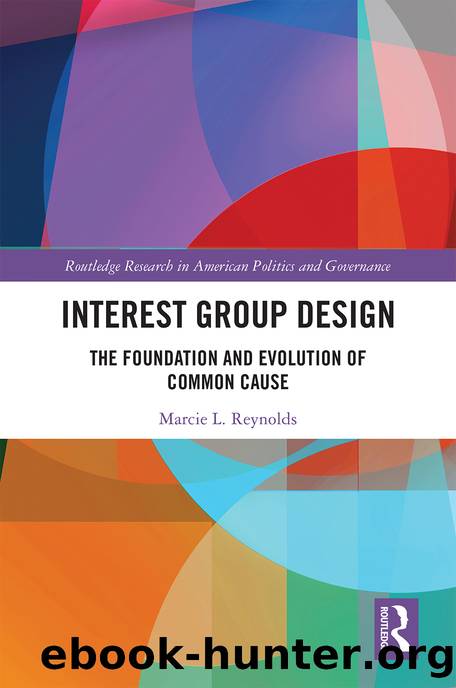Interest Group Design: The Foundation and Evolution of Common Cause by Marcie Reynolds

Author:Marcie Reynolds [Reynolds, Marcie]
Language: eng
Format: epub
Tags: International Relations, European, Political Science, World, General
ISBN: 9781000004786
Google: Zh-eDwAAQBAJ
Goodreads: 44229769
Publisher: Routledge
Published: 2019-06-07T10:13:39+00:00
Public Opinion and Cynicism
In a 2014 interview with historian Pauline Peretz, Fred Wertheimer (Common Cause President from 1981 to 1995) assessed changes in public opinion. He observed in the late 1960s and early 1970s âpeople were angry and upset, but they were not cynical . . . [they thought something] could be done and did do something, as opposed to today.â He added now it is more difficult to get people to think something can be done. Congress is totally dysfunctional (âyou canât pass anythingâ) and the Supreme Court is very hostile.
Public opinion polls (see Appendix B: Government Operations and Public Trust) empirically support Wertheimerâs assessment. Recently, the number of people who believe government operations is the most important problem rose to mid-1970s Watergate-era levels. Trust in the federal government to do what is right almost all of the time is lower than it has ever been in over fifty years of poll data.
A Common Cause leader recalled the organizationâs original vision was that everyone shares an interest in government operating in its proper arena in line with governance integrity being a public quality (based on âRepresenting Public Qualities,â Sultan Tepe and Andrew McFarland, typescript, University of Illinois at Chicago, Department of Political Science), whatever their ideological perspective. Yet in 2014 âPeople have a sense government is rigged by the wealthy which leads to a toxic downturn in participation.â Cynicism rose as increasing amounts of money were spent during elections, the Supreme Court undid campaign finance reforms, presidents disappointed, and Congress was viewed as a âjoke.â
Congruence between Common Cause issues, public opinion, and political opportunities changed over the organizationâs history. Common Cause arose in conjunction with the social movement of the late 1960s and early 1970s and quickly attracted a national following. Forty years later its name is less well known. Leaders explained Common Causeâs voice has been joined by many other groupsâ voices over the years, which tended to drown them out. In the mid-2000s, Common Cause issues, public opinion, and political opportunity coalesced around congressional ethics reform. Common Cause, and other groups, worked to hold lobbyists and Members of Congress accountable.
Download
This site does not store any files on its server. We only index and link to content provided by other sites. Please contact the content providers to delete copyright contents if any and email us, we'll remove relevant links or contents immediately.
AI Native Enterprise: The Leader's Guide to AI-Powered Business Transformation by Yi Zhou(274)
Challengers: How a New Breed of Leaders Collaborates and Wins in a Hyper Competitive World by Ben-Attar Saar(268)
Time is Now: A Journey Into Demystifying AI by Raj Verma(235)
Stoic at Work by Annie Lawson(222)
Change Management that Sticks by Barb Grant(207)
Leadership Team Alignment by Frédéric Godart(192)
Impact with Love: Building Business for a Better World by Greg Harmeyer(191)
Startups Grow With People by Dagdeviren Ozan(175)
Reconstructing Inclusion by Amri B. Johnson(169)
People and Data by Redman Thomas C.;(168)
You're Too Smart for This : (Beating the 100 Big Lies About Your First Job) by Michael Ball(166)
Leading and Managing Change in the Age of Disruption and Artificial Intelligence by Donald Mathew;(164)
9 Powerful Practices of Really Great Teams by Stephen E. Kohn(162)
Corporate Fraud Exposed by Baker H. Kent;Purda Lynnette;Saadi Samir;(160)
Change Your Business with NLP by Lindsey Agness(151)
How to Speak Human by Jackson Dougal;Jackson Jennifer;(151)
The Executive Warrior by Ng Victor;(145)
Leadership Transitions by Richard Elsner(142)
Outpacer by Alex Holt(141)
